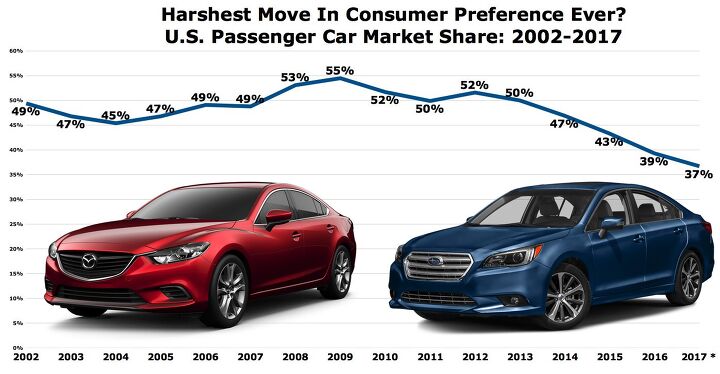How Far and How Fast Has U.S. Passenger Car Market Share Fallen? So Far, and so Fast
37 percent of the new vehicles sold in the United States in the first seven months of 2017 were passenger cars. That’s correct. 63 percent of the new vehicles now sold in America are pickup trucks, SUVs, crossovers, and vans.
But how did we get to this 37-percent basement? When did we get here? How long did it take to get here? And is it really the basement?
Answers: we got here with the rise of crossovers, we began the approach to our current destination in 2013 (though the rate at which we approached has rapidly increased), and we might not be at the end of our journey quite yet.
“This was the harshest move in consumer preference the industry has ever seen,” Toyota executive vice president for North American sales, Bob Carter, tells Wards Auto.
To critics who suggest Toyota, and the industry at large, didn’t see the move coming, Carter points right at the auto industry’s own trend-spotting. “Did the industry see it coming? Yes, or you wouldn’t have what you have today.”
New vehicles in new sectors, such as Toyota’s C-HR and the RAV4 Hybrid, don’t simply fall from the sky. The new vehicles Toyota is selling this year are the fruit of a product cycle that began half a decade ago.
Whatever the cause of the shift — and there are fuel economy regulations and fuel prices and AWD marketing all at play, among other factors — the shift has been noteworthy both for the degree to which traditional passenger cars have lost their hold on the market and because of the speed with which they lost that hold.
Now the mission is to determine whether the shift is complete, whether a 37/63 split represents the basement for passenger cars. Carter has said in the past that the current state of passenger car market share is likely to hold steady.
The investment in Toyota’s Kentucky Camry plant — there are now more workers at the Georgetown plant than ever before — speaks to Toyota’s belief that the car sector has reached bottom.
A five-year trend suggests otherwise.
[Image: Toyota]
Timothy Cain is a contributing analyst at The Truth About Cars and Autofocus.ca and the founder and former editor of GoodCarBadCar.net. Follow on Twitter @timcaincars.
More by Timothy Cain
Latest Car Reviews
Read moreLatest Product Reviews
Read moreRecent Comments
- 28-Cars-Later I'm getting a Knight Rider vibe... or is it more Knightboat?
- 28-Cars-Later "the person would likely be involved in taking the Corvette to the next level with full electrification."Chevrolet sold 37,224 C8s in 2023 starting at $65,895 in North America (no word on other regions) while Porsche sold 40,629 Taycans worldwide starting at $99,400. I imagine per unit Porsche/VAG profit at $100K+ but was far as R&D payback and other sunk costs I cannot say. I remember reading the new C8 platform was designed for hybrids (or something to that effect) so I expect Chevrolet to experiment with different model types but I don't expect Corvette to become the Taycan. If that is the expectation, I think it will ride off into the sunset because GM is that incompetent/impotent. Additional: In ten years outside of wrecks I expect a majority of C8s to still be running and economically roadworthy, I do not expect that of Taycans.
- Tassos Jong-iL Not all martyrs see divinity, but at least you tried.
- ChristianWimmer My girlfriend has a BMW i3S. She has no garage. Her car parks on the street in front of her apartment throughout the year. The closest charging station in her neighborhood is about 1 kilometer away. She has no EV-charging at work.When her charge is low and she’s on the way home, she will visit that closest 1 km away charger (which can charge two cars) , park her car there (if it’s not occupied) and then she has two hours time to charge her car before she is by law required to move. After hooking up her car to the charger, she has to walk that 1 km home and go back in 2 hours. It’s not practical for sure and she does find it annoying.Her daily trip to work is about 8 km. The 225 km range of her BMW i3S will last her for a week or two and that’s fine for her. I would never be able to handle this “stress”. I prefer pulling up to a gas station, spend barely 2 minutes filling up my small 53 liter fuel tank, pay for the gas and then manage almost 720 km range in my 25-35% thermal efficient internal combustion engine vehicle.
- Tassos Jong-iL Here in North Korea we are lucky to have any tires.



































Comments
Join the conversation
I envy Toyota, Nissan, and Honda. Even in this age of the SUV, they still thousands of sedans and compacts each year. In fact the Camry and Accord easily outsell most GM trucks and SUVs.
Woo hoo! The station wagon and hatchback have triumphed in the end! Sure, we have to give today's wagons a little excess ground clearance and call them a Crossover, but these are just tall, practical station wagons. Hatchbacks are dead, unless you put a hybrid power-train in them and then you have The Prius! The two most rational configurations for flexibility, usability, drive-ability and efficiency have won!!!! Meanwhile, stupid configurations like two door coupes and big on the outside, small on the inside sedans are getting run out of town. Time to party!%$$%^*)&)&(*)(*&_!